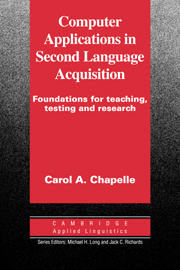Book contents
- Frontmatter
- Contents
- Series editors' preface
- Thanks
- Abbreviations
- 1 Historical foundations of CASLA
- 2 The context and challenge for CASLA
- 3 Computer-assisted language learning
- 4 Computer-assisted language testing
- 5 Computer-assisted SLA research
- 6 Directions for CASLA
- References
- Author index
- Subject index
2 - The context and challenge for CASLA
Published online by Cambridge University Press: 05 October 2012
- Frontmatter
- Contents
- Series editors' preface
- Thanks
- Abbreviations
- 1 Historical foundations of CASLA
- 2 The context and challenge for CASLA
- 3 Computer-assisted language learning
- 4 Computer-assisted language testing
- 5 Computer-assisted SLA research
- 6 Directions for CASLA
- References
- Author index
- Subject index
Summary
The history of CASLA in the previous chapter revealed some of its interconnections with other academic areas, and in fact, developments in CASLA were precipitated by work in related fields. It is informative, therefore, to look more carefully at what these areas have to offer, particularly in terms of methods for evaluation. This chapter points out some of the important contributions of other areas for the technical infrastructure of CASLA as well as some general orientations to evaluation issues. At the same time, it argues that the specifics of evaluation for second language learning and assessment must be developed from relevant perspectives in applied linguistics.
Disciplines related to CASLA
In education, linguistics, and psychology, computer applications have been the subject of scholarly inquiry, thereby creating sub-disciplines directly relevant to CASLA such as ‘educational technology’ and ‘computational linguistics.’ Six such computer-related subdisciplines have made significant contributions to CASLA: educational technology, computer-supported collaborative learning, artificial intelligence, computational linguistics, corpus linguistics, and computer-assisted assessment. Because these six have provided bases for CASLA, a brief examination of each will help to define CASLA from a historical, disciplinary perspective which reveals the origins of some current philosophies and practices.
Educational technology
CALL has its roots in educational technology, a specialization within the study of education that has been active since the 1960s (Reiser, 1987; Saettler, 1990). By the early 1970s, a number of journals devoted to the topic had begun: Programmed Learning and Educational Technology (appeared in 1964), Educational Technology (appeared in 1966), Journal of Educational Technology (appeared in 1972), and Journal of Computer-Based Instruction (appeared in 1974).
- Type
- Chapter
- Information
- Computer Applications in Second Language Acquisition , pp. 27 - 43Publisher: Cambridge University PressPrint publication year: 2001



